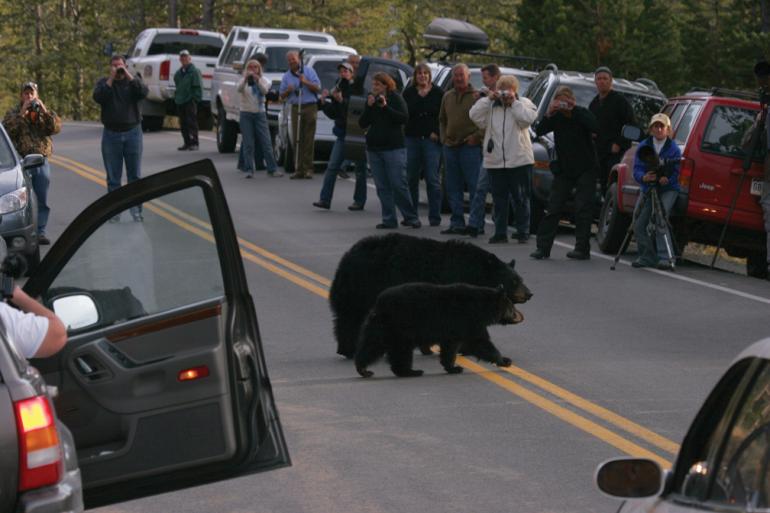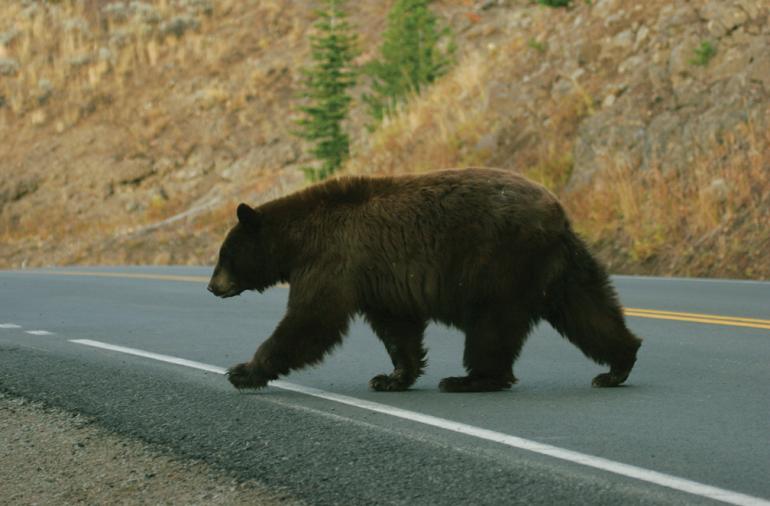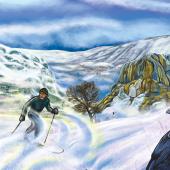Bear Jam
I saw the two bears from the road while driving. Like a proper tourist, I stopped right in the middle of the road. Since I was on a curve, I did the responsible thing—I turned on my hazards. A minivan drove by and nearly swiped my mirror, so I pulled over another foot and a half, which was as much as the nonexistent shoulder would let me. As the next driver swooped by, I made the bear sign with my hand and pointed. I doubt they noticed over their own expletives or if they even knew the bear sign, but they followed with a sign of their own.
I drove to the next pullout and discovered I could see the bears just fine from the safety of a roadside pullout. I shut the truck off, grabbed my binocs, and climbed up onto the topper to have a better look. They were a mother and cub. Mama was dark brown and had the characteristic shoulder hump, broad head, and chest of a grizzly. Her cub looked healthy, bouncing rambunctiously around her while she foraged.
Within moments, several other cars had pulled over to see what I was looking at. That’s just how it goes in Yellowstone—or any other national park for that matter. Stop and break out the binoculars, and you’ve soon got a crowd on your hands. I don’t necessarily mind crowds, but I don’t like being trapped in a parking area by a cavalcade of motorists. And unless you’re willing to actually hike some distance away from pavement, crowds happen.
Mama and cub foraged their way behind a small rise in the sage flats of Blacktail Deer Plateau. So I drove to the next pullout—a proper trailhead with parking. This time, I had to actually leave my vehicle to get a view of the bears. After a 30-second hike in flip-flops, I arrived at my destination—a “Caution: Bear Frequenting Area” sign. I climbed on top of the sign and sat straddling the cross brace when a man behind me gasped, “Oh no, there they are—in the creek!”
The man’s concern stemmed from two fishermen rhythmically casting their fly lines, unaware of the bears wading the creek just 50 feet behind them. “BEAR!” the tourist yelled, as if there were the slightest chance the fishermen—half a mile away and surrounded by rushing water—could possibly hear him.
But the hapless fishermen couldn’t hear the tourist, nor did they notice the mother and cub trundling along behind them. Thankfully, mama didn’t seem to notice them either, and had the fisherman detected the bears so close, they may have panicked and done something foolish like charge the bears for that once-in-lifetime photo opportunity.
Pretty soon, throngs of tourists arrived at the trailhead, braved the epic hike, and clustered around my hard-won pinnacle. As soon as mama and cub disappeared behind the next rise, I hopped off my perch and hurried back to the truck. Blazing back down the highway, I swooped into the next pullout while the traffic jam gathered back at the trailhead—I was staying just ahead of the curve.
My new vantage commanded a view of the sage flats falling away to the creek that mama and cub had just crossed. Even so, it was hard to keep track of the bears—the sage-brushed landscape alternately swallowed them up and then spit them back into view.
Soon, tourists began congregating at my new spot. I invited a French-speaking family to watch with me, and the father lifted his little girls up onto the topper of my truck. We all shared my binoculars. When they said “thank you,” I replied, “je vous en prie.” The mother and father smiled quizzically, making me wonder what I had just said. When the little girls mentioned “l’ours,” I said, “le petite ours,” and they giggled.
Over the next half-hour, it became clear that mama wanted to cross the road near the creek, but the bumper-to-bumper traffic held like a wall of Spartan soldiers, steel glistening in the sun. Repeatedly mama moved to cross the road while cub tentatively reared up behind her. Repeatedly she was turned back, cameras flashing, hands gesticulating. The French family left me for the scene of action, which was a quarter mile further down the road. “I have a feeling they’ll feed right to us if you wait here,” was all I could say before they left.
Gradually the bears made their way up the sage flat, coming toward me, paralleling the road. Every now and then, mama threw a cautious glance toward the road, looking for a break. There was none. But it’s amazing how fast a grizzly can cover ground, even casually. Mama appeared to be in no hurry, but within seconds, mama and cub had arrived near my position on the road. The line of traffic had followed them and I was boxed in.
The French family was back and I handed one of the little girls my binocs, the bears just 75 yards from us. Mama seemed to be making another move for the highway and inspiration suddenly struck me. I hopped off my topper and started running for the front of the line of cars. The French dad called after me and held up the binocs with a questioning look. “Toss them in the cab,” I shouted over my shoulder as I sped away.
My thoughts raced ahead of my feet. “The bears have good cover right up to the road’s edge in that one spot ahead, and no oncoming traffic is arriving at the moment. If I can just get the line to stop for a minute they might make it across!”
I made contact with the lead car. The driver already had the same plan in mind. But pedestrians started pushing past the front vehicle and I asked them to wait. Then a parked vehicle tried to pull in front of the line and I asked them to wait too. While I was talking to that driver, I caught movement out of the corner of my eye and watched as mama and cub burst from cover and loped across the pavement. It was done; inwardly I let out a cry of relief and didn’t realize ‘til then how anxious I had become.
What is it about wild animals that make us go gaga? Why do adults and otherwise normal human beings abandon common sense and consideration when coming into close contact with powerful wild animals? In our excitement to get close to the grizzlies, we—the tourists—blocked their path across the highway. Our desire to be close to them overrode our consideration for their needs and for each other as we all scrambled for the best view. Traversing the line of cars was an obvious stressor—even for the mighty grizzly—a stressor that the excited observers either failed to notice or chose to ignore.
Having encountered dozens of grizzlies in Alaska—unarmed—I’ve become keenly aware of their body language (call it a survival skill). And, unlike the proverbial chicken, the bears did not simply cross the road. I believe that most people watching them did not realize they wanted to cross the road. Otherwise, they would have let them pass. And maybe some, like me, saw what was happening but felt powerless to do anything about it—how do you organize two opposing lanes of traffic and get everyone to act as a disciplined unit—in a matter of minutes and with no authority whatsoever?
I continued watching mama and cub for a while after they made the great crossing. They were doing fine, doing what bears do—eating, playing, and melting away into the sagebrush—at their own pace. I felt good watching them go, like I had reconnected with them and with something in me. I need wildlife and wild places, and deep down, I think everybody does. I was glad to be there that day, to play the part I did, and to remind myself that relationships are everything. From leadership to love to fitting in with the natural world, relationships are everything. And for just a moment, I felt like I’d gotten it right.














